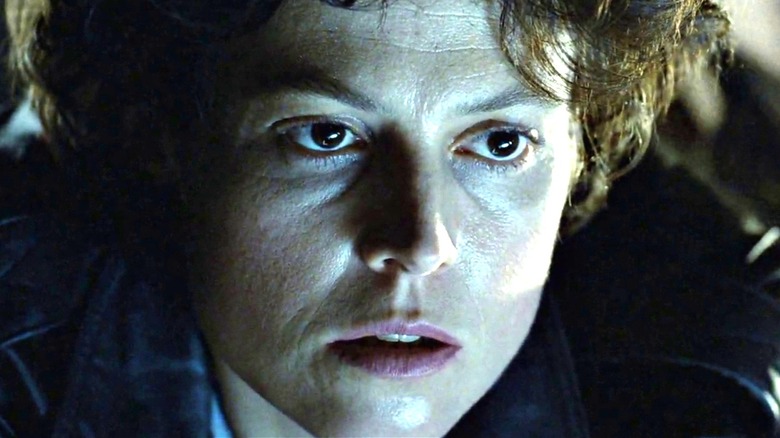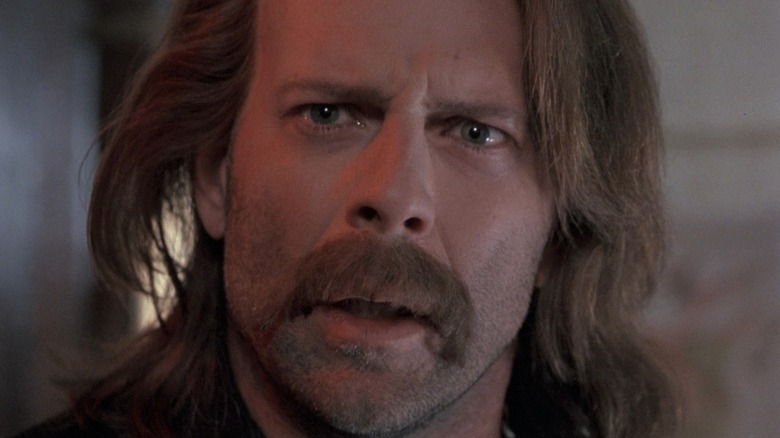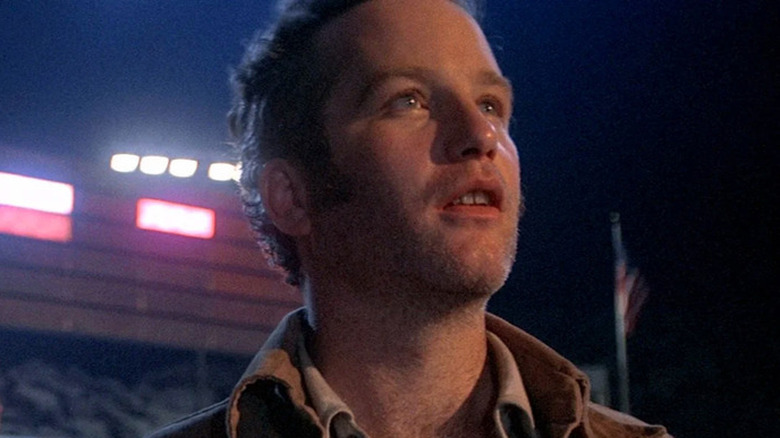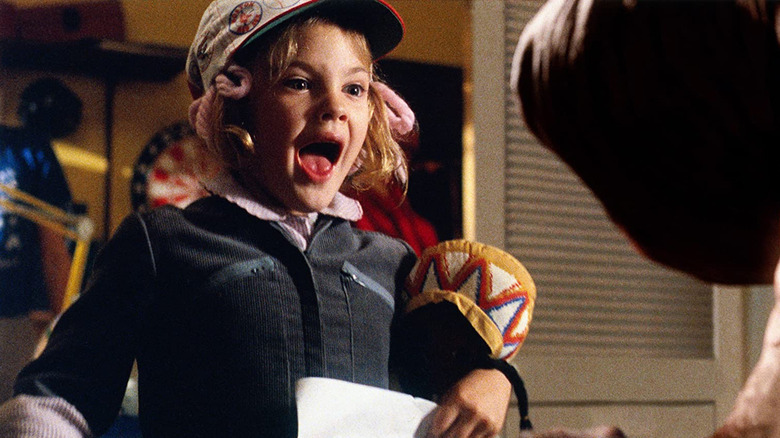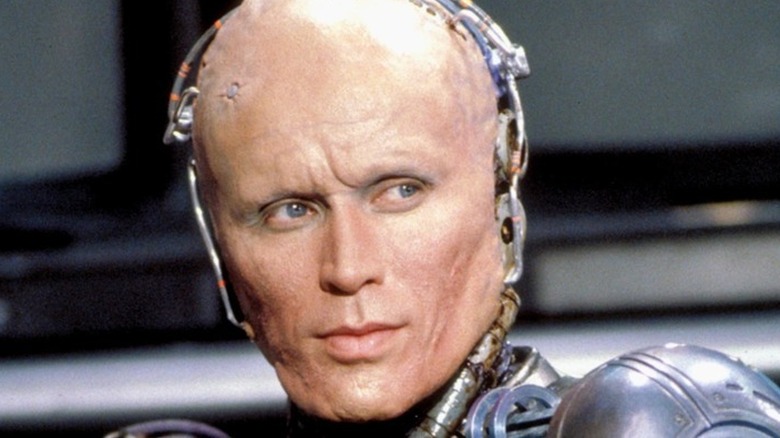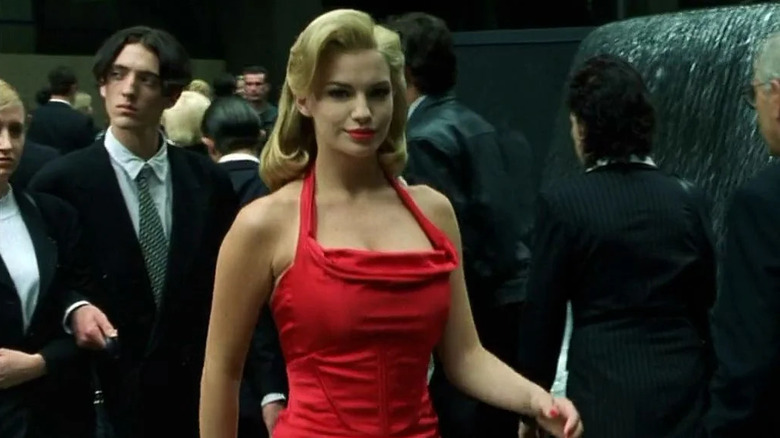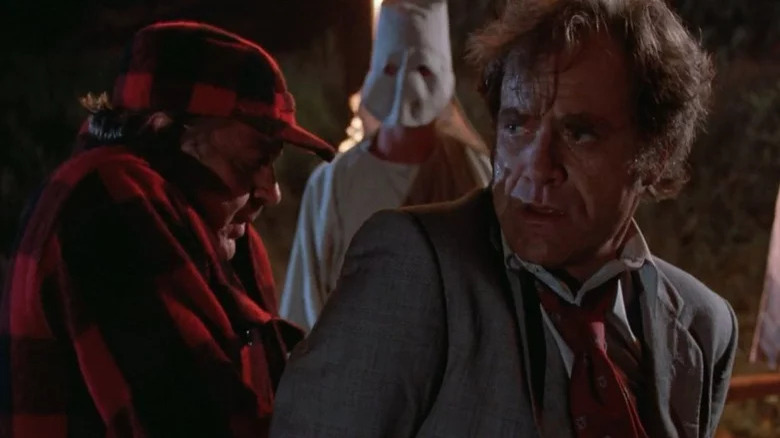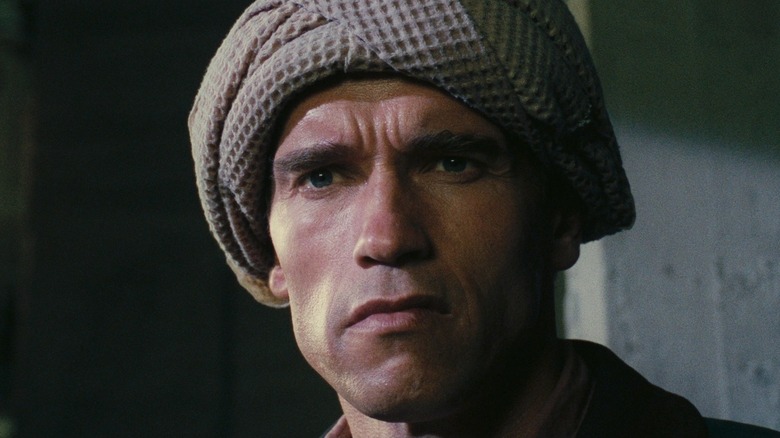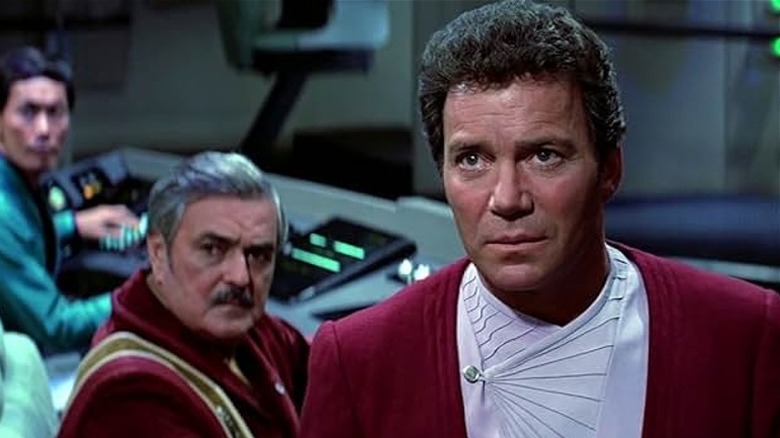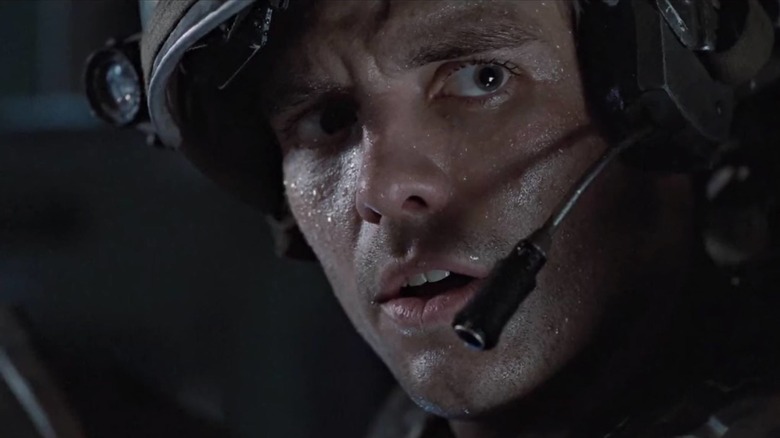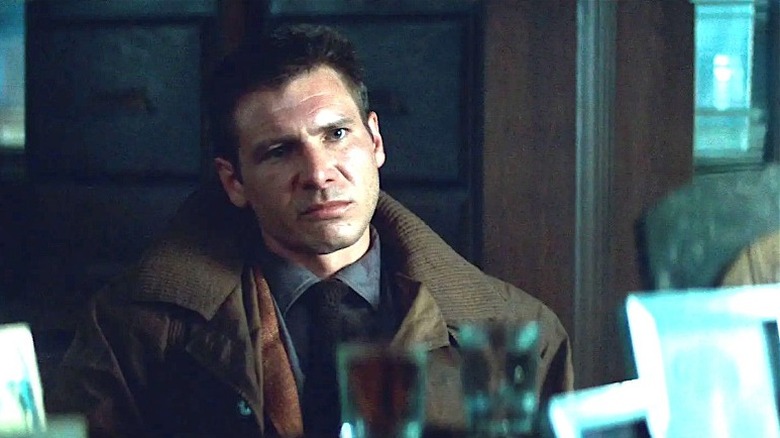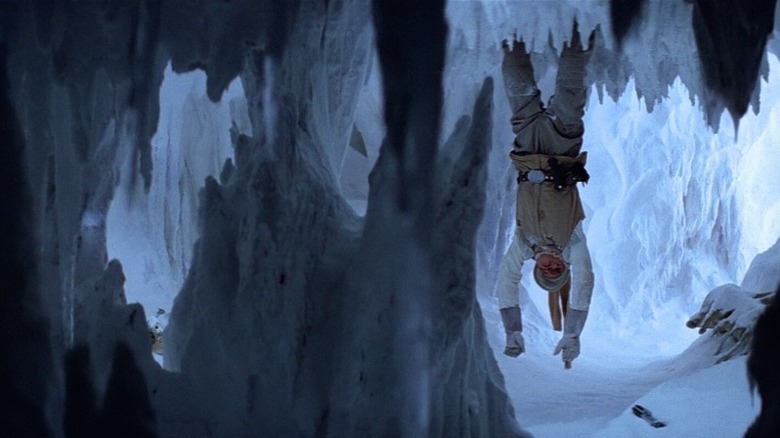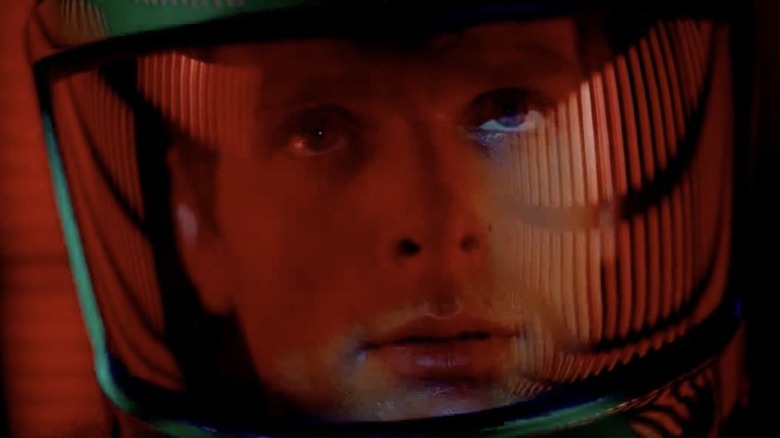Wild Stories From Science Fiction Films That Are Actually True
Making a movie in Hollywood is never an easy or simple undertaking. Whether it's a big studio blockbuster or a small indie film, productions take months or years of planning and prep work thanks to intense coordination and oftentimes nightmarish logistics ... and that's before the cameras even roll. While this is usually the case for a typical film, the difficulties get compounded with science fiction movies, which can have added challenges of complicated stories, elaborate sets, and expensive special effects.
While the making of sci-fi stunners like "Star Wars" or "RoboCop" may bring bigger obstacles, the results are worth the added effort. Perhaps not surprisingly, these complicated productions have some unbelievable behind-the-scenes stories that might seem lifted straight out of a sci-fi script. These moments range from fights on set to the extraordinary lengths that filmmakers went to in order to bring their imaginative visions to life. So, set the hyper drive wayfinder to maximum and prepare for light speed, because we've found some wild stories from the making of your favorite science fiction classics that all really happened.
The filming of 12 Monkeys stopped for one hamster
Director Terry Gilliam is responsible for a number of iconic films like "Fear and Loathing in Las Vegas" and "Brazil." As is clear in all of his films, Gilliam has a meticulous eye for detail, which is what got him in trouble on the set of his 1996 film "12 Monkeys." The film centers around James Cole (Bruce Willis), who is sent back in time to stop a deadly plague. But for one day during production, a single hamster made time stand still, all because of Gilliam's obsession with perfection.
As covered in the documentary "The Hamster Factor (and Other Tales of 12 Monkeys)," the movie was plagued with problems, from budget crunches to negotiations between the studio and Gilliam on the final cut. But the biggest hurdle came while filming a sequence set in a post-apocalyptic future. "We built a little laboratory set in a gas turbine, and Bruce Willis was sitting naked, drawing his own blood," said co-producer Lloyd Phillips. In the background of the frame was a hamster in a wheel, but when cameras rolled, the rodent didn't budge. "Terry that night was more pre-occupied with getting the hamster to perform than he was Bruce Willis," said Phillips, while noting how Gilliam's obsession with the little things often delayed filming.
Eventually, Gilliam got the shot he needed after an entire day of filming, but the irony is that most audiences probably didn't even notice the hamster. Laughing about it, Gilliam admitted that "It's a bit of detail that probably doesn't mean anything to anybody but myself."
Close Encounters had high closing costs
Steven Spielberg has made some of the best and most celebrated sci-fi films of his generation, from the 2002 actioner "Minority Report" with Tom Cruise, to the 2001 drama "A.I." But his first foray into the genre was some 20 years before with the sci-fi drama "Close Encounters of the Third Kind," which was released in 1977, the same year as George Lucas' "Star Wars."
Featuring similarly groundbreaking visual FX — designed by Lucas' pals Ralph McQuarrie and Dennis Muren — the film features an iconic movie moment that takes place in the home of the film's protagonist, Roy Neary (Richard Dreyfuss).
Rather than use a Hollywood set, Spielberg wanted to film on location to better capture Roy's home in middle America. However, his team had such trouble finding the right residence that they were forced to buy one.
Spielberg's original plan was to film in Los Angeles, which it turns out, doesn't double particularly well for the midwest. So, production designer Joe Alves did extensive scouting and found the perfect home in Mobile, Alabama. The problem was, the house needed to be renovated to work for the film and the best way to do that would be to purchase it. The studio refused to do so, and that's when Alves himself stepped in.
As Alves described to The New York Post in 2017, he and associate producer Clark Paylow offered to put up the money to buy the house themselves and then rent it to the studio, which forced Universal to reconsider. Universal Studios purchased the home for $35,000, and after filming, re-sold it for a pretty decent profit.
E.T. was more than a puppet
"Close Encounters" was an instant classic, and is still remembered as one of the genre's best, but arguably, Spielberg's most famous sci-fi movie is "E.T.: The Extraterrestrial," which became one of the biggest box office earners of all time. The film introduced audiences to one of the most recognizable aliens in cinema history, with the titular E.T. dazzling audiences thanks to lifelike effects and a performance that tugged at the heartstrings. In fact, E.T. was so convincing that at least one cast member believed that the alien was a living, breathing friend.
As revealed on her talk show "The Drew Barrymore Show" in 2022, former child star Drew Barrymore — who was just six-years-old during filming — really believed that E.T. was a flesh-and-blood creature from another world. Barrymore had an "E.T." cast reunion on her show that included Henry Thomas, who played her brother Elliott, and Dee Wallace, who appeared as her mother in the film.
Thomas described how Barrymore asked wardrobe to bring the alien puppet a scarf to keep him warm in between takes, while Wallace told her that "we found you over there, just talking away to E.T." when the camera wasn't rolling.
Wallace let Spielberg know what was going on, and the story gets even more endearing, as the director didn't want to break the illusion for the child star. Once Spielberg found out Barrymore believed in E.T., Wallace said that he "appointed two guys to keep E.T. alive, so whenever you came over to talk to him, he could react to you."
RoboCop was so dangerous they had to give actors bonus pay
"RoboCop" may be the epitome of '80s action, as it tells the story of a futuristic lawman, who's unafraid to blow away the baddies while trying to bring them to justice. Full of over-the-top gore and big time action, some of the stunt work on the film was so excessive that it even shocked its cast. In fact, one infamous incident occurred that put performers in so much danger that they were given extra hazard pay.
Following years-long rumors about an out-of-control explosion at a gas station, director Paul Verhoeven confirmed the unexpected fireworks in an interview with the Dallas Observer in 2017. "It was probably bigger than we thought," Verhoeven admitted. But that wasn't actually the source of the rumors that actors received extra pay for being put in harm's way.
Verhoeven revealed that there's another explosion towards the end of the movie, "when he shoots in the window of a store there, and that was such a big explosion, you can see it even in the reaction of the actor. ... We were all shocked." Kurtwood Smith, who played the movie's villain, was that actor and he wasn't happy about this unexpected turn of events. Smith told Esquire that the explosion was so big that it set his coat on fire. Afterwards, he and other actors were offered stunt pay and Smith lamented, "Stunt pay was something like $400. '$400?! You set fire to me, then you give me $400?!'"
The woman in red crashed a car
Cinema history is full of watershed movies, which transform the industry and offer a new direction in movie-making. The 1999 film "The Matrix" was one such movie, with its mix of revolutionary special effects and groundbreaking, mind-bending story that became a guidepost for a generation. The making of the Wachowski sisters' film is full of fascinating nuggets and strange stories. But perhaps the wildest of all involves the so-called "woman in the red dress," who is central to a key scene in the film.
Kym Barrett, the movie's costume designer, talked about an incident when actress Fiona Johnson — who played the woman in the red dress — first arrived on set. "We're coming down the road and all the guys on the crew are like falling over and dropping their coffee and ogling this poor girl," she said in a feature on the movie's home video release. "There's a big roller door where they all come out at the end of the day and this guy drives out, sees her standing there, stops the car." Barrett laughed as she described the driver, who fell into in a trance-like state at the sight of Johnson.
"The roller door slams into the top of his car," Barrett continued, which startled the driver so much that he panicked and drove forward, leading the roller door to scrape across his entire car and crack his windshield. The guy was so mortified that he fled the scene and Barrett joked that "we don't know how he's going to explain that to his wife."
An on-set accident killed three people on The Twilight Zone movie
1983's "Twilight Zone: The Movie" featured big budget remakes of three classic "Twilight Zone" TV episodes plus one original story. Some of the era's best filmmakers took part: George Miller and Joe Dante directed along with Steven Spielberg and John Landis, who also co-produced the film together.
But the making of "Twilight Zone: The Movie" led to one of the most infamous tragedies ever on a movie set when a helicopter accident took the lives of three people (per History). On the final day of shooting Landis' segment — the film's original story – a helicopter was used for a critical scene set during the Vietnam War.
The sequence involved two young children — child actors Myca Dinh Le and Renee Shin-Yi Chen — who were supposed to run from an attacking helicopter. But when special effects explosives unexpectedly hit the helicopter, it careened out of control, crashing into and killing both children, along with the segment's star Vic Morrow.
In the aftermath of the incident, members of the crew — including Landis — were brought in on charges of involuntary manslaughter, of which they were ultimately acquitted. However, Landis and others violated numerous child labor laws by illegally hiring the children (per TruTV), so the kids' parents brought a civil suit against producer Steven Spielberg and studio Warner Bros. It was eventually settled out of court and the horrific disaster led to more stringent safety measures on movie sets (per Slate).
Chaos on the set of Total Recall
In the 1980s, Arnold Schwarzenegger went from premiere body builder to superstar big screen action hero thanks to leading roles in "Conan the Barbarian" and "The Terminator." He kicked off his successful '90s run with "Total Recall," which was director Paul Verhoeven's follow-up to his 1988 classic "RoboCop." And once again the director found himself leading an uncontrollable production, as the project was plagued by constant problems from food poisoning to stunt scenes that led to injury.
In a 2015 interview with Yahoo! Movies, Schwarzenegger described the wrist slashing he endured during a stunt gone wrong while making the film. It happened when his character Douglas Quaid crashes through a window. "They did not explode the window before I hit the window with the gun," the actor recalled. "I cut my wrist deep. And I had to get stitched up during a lunch break, which was at like midnight, because we were night shooting." Schwarzenegger had to finish the scene, so he got his wrists taped up and hid the bandages under a jacket.
But that was hardly the only problem faced during production. The crew was struck with a serious case of food poisoning while on location in Mexico City, which knocked everyone out except for Schwarzenegger (per Yahoo! Movies). The star had previously gotten ill while filming "Predator" in Mexico, so he decided to have his food and water brought in from the U.S., which saved him some further unpleasantness since the wrist injury sounds bad enough.
Captain Kirk answers a real-life distress call
Filming an action movie can be fraught with danger, but it's not often that the risks come from outside the production, as they did on the set of 1984's "Star Trek III: The Search for Spock." While filming was underway on the franchise's third installment on Paramount's backlot, the cast and crew of the film were confronted with a terrifying scene: a massive blaze that nearly engulfed the entire studio (per UPI).
While the fire did millions of dollars in property damage and destroyed several key Paramount backlots including a recreation of New York used for such classics as "The Godfather" and "Chinatown," it might have been much worse if Captain Kirk himself hadn't answered the distress call.
According to actor William Shatner, who plays Kirk in the film, he leapt into action to help fight the inferno, as it threatened to destroy the "Star Trek" sets they were filming on. "I went into our magnificent set and a group of people — carpenters, stagehands, actors — had a hose on the stage that was starting to burn. If it had burned, our whole set would have gone."
Thankfully, firefighters arrived quickly, and while several large standing sets were burned down, the "Star Trek" sequel suffered only minor damage (per UPI). But as Shatner tells it, it was a close call. "The fire was just starting on the wall, we were 30 seconds away from losing it," he later told ABC News.
Aliens needed a new actor when its star was arrested
"Terminator" director James Cameron took the eerie, horror-flavored "Alien" and turned it into a rip-roaring action movie for the 1986 follow up to Ridley Scott's 1979 classic. "Aliens" featured a new cast that only carried over the original film's lead Sigourney Weaver as Ellen Ripley.
To fill out the ensemble, Cameron brought with him a few of his "Terminator" stars, including Michael Biehn. But Biehn actually wasn't the first choice for his role, and when cameras started rolling on the picture, he wasn't the man playing Corporal Hicks. Instead, James Remar was originally tapped to play Corporal Hicks and the story of how Biehn got the part after filming commenced isn't what you might expect.
Though it was long known that Biehn joined the cast late to replace Remar, the reason had always been elusive. According to Empire Magazine, Remar's departure was chalked up to "creative differences," but the true story finally came to light in 2014. Clearly those involved were uncomfortable with speaking for Remar over the years, but the actor himself came clean in an interview with Sidebar (via Den of Geek).
"I had a terrible drug problem, but I got through it ... I was initially cast as Corporal Hicks, and I was fired after a couple weeks of filming because I got busted for possession of drugs, and Michael Biehn replaced me." Needing a new actor at the 11th hour, producer Gale Anne Hurd called on old friend Biehn, who was happy to step into the role with no training or prep time.
Foul-mouthed T-shirts on the set of Blade Runner
After "Alien," director Ridley Scott turned his attention to the sci-fi crime noir thriller "Blade Runner." The film starred Harrison Ford fresh off his debut as the whip-wielding relic hunter Indiana Jones in "Raiders of the Lost Ark," and the two superstars found themselves butting heads over whether Ford's character Rick Deckard was actually a replicant. But that disagreement was far from the only problem Scott created with his crew. The wildest one involved disgruntled staffers and some custom t-shirts with some coarse language aimed at their director.
As recounted by Vanity Fair, the production of the film was well behind schedule and everyone was exhausted from long hours and little rest. Just when the crew was feeling the strain at its worst, director Ridley Scott gave an interview with British media outlet The Guardian that turned them against him.
In the interview, Scott declared his love of working with British film crews over their American counterparts because they responded to requests with an enthusiastic "Yes, Guv'nor." Back on the set, his American crew wasn't too happy when they read his comments, which sparked a strange form of T-shirt warfare.
Marvin Westmore, the film's makeup supervisor, designed and printed custom t-shirts for the Americans to wear with "YES GUV'NOR" and an expletive emblazoned on them. The British crew members began sporting their own custom tees that read "XENOPHOBIA SUCKS," which served as a T-shirt detente.
The accident that may have forced an iconic Star Wars scene
There's a well-known legend that injuries suffered in a car accident helped spawn a famous "Star Wars" action sequence. It begins in January of 1977, when reshoots on the then-upcoming "Star Wars" had just wrapped and the film's star Mark Hamill got into a car wreck that forever altered his facial features. The story went that the sequence at the beginning of "The Empire Strikes Back" in which Luke is mauled by a snow beast and forced to undergo a long medical recovery was written to explain Hamill's changed look.
In 2020, Insider chronicled the history of the story, and it includes quotes from actress Carrie Fisher, who confirmed the rumors. "I was still shooting 'Star Wars' when Mark got into the car accident," she said on the Blu-Ray commentary for the film. "Miraculously his teeth didn't shatter. But his nose did. ... So they adjusted the film with this snow monster to right away in the movie scratch his face to account for his looks being different."
While Hamill himself has never commented, George Lucas splashed a bit of cold water on the story, claiming that while the scene did help to explain Hamill's new look, the accident "wasn't really the meaning of why we wrote the monster in the beginning." Whatever the truth may be, it's clear that Hamill's accident was a major discussion point while producing the 1980 sequel.
Kubrick destroyed every model from 2001: A Space Odyssey
Some of the most indelible images in sci-fi history involve iconic starships, weapons, and other props from franchises like "Star Wars," "Star Trek," and "Doctor Who." And while many of the original models and props used in the making of such classics have survived — and in some cases, sit on display in museums, like the Starship Enterprise in the Smithsonian — one groundbreaking sci-fi classic has almost no surviving props. But rather than having been lost to time or mistake, the models and props used in "2001: A Space Odyssey" were destroyed deliberately at the instruction of the film's director, Stanley Kubrick.
Before you decry the legendary director for such casual disregard for film history, there was actually a method to his madness. Far Out Magazine went into detail about just why Kubrick had every physical element be destroyed, and it all stems from Hollywood's long history of re-using expensive props in multiple productions. As just one noteworthy example, the robot known as "Robbie" built for the 1956 classic "Forbidden Planet" was reused on television shows like "Lost in Space" (per New Atlas), whose own robot B9 was reused in a TV series called "Mystery Island."
Not wanting to see the expensive, high quality models he had crafted for his seminal sci-fi masterpiece used is lesser projects, Kubrick chose to have them destroyed. Given how common the reuse of props and models was in sci-fi particularly in that era, it may have been a wise move.
